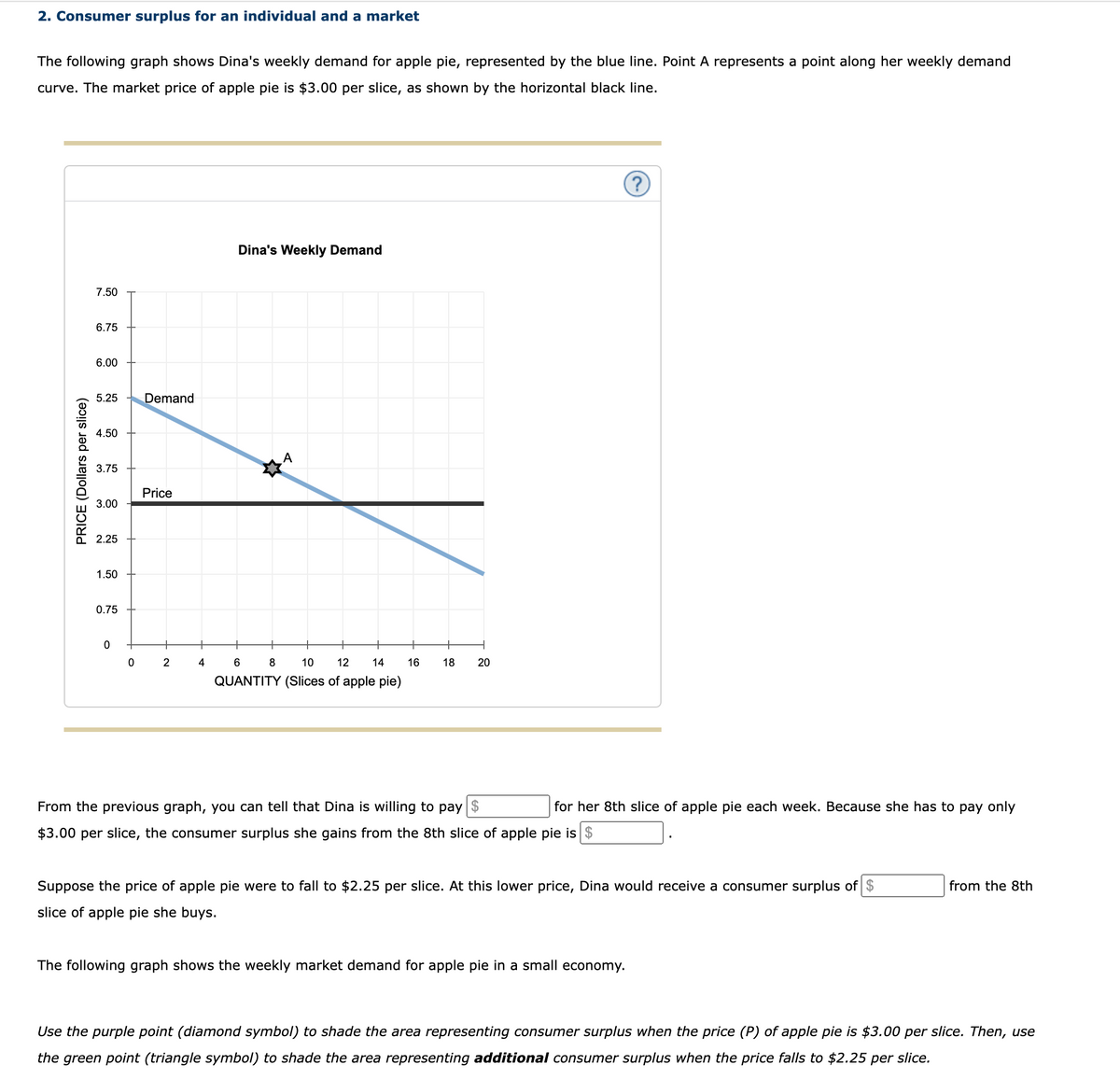Consumer surplus for an individual and a market following graph shows Dina's weekly demand for apple pie, represented by the blue line. Point A represents a point along her weekly demand ve. The market price of apple pie is $3.00 per slice, as shown by the horizontal black line. Dina's Weekly Demand 7.50 6.75 6.00 5.25 Demand 4,50 3.75 Price 3.00 2.25 1.50 0.75 2 4 6 8 10 12 14 16 18 20 QUANTITY (Slices of apple pie) m the previous graph, you can tell that Dina is willing to pay $ for her 8th slice of apple pie each week. Because she has to pay only 00 per slice, the consumer surplus she gains from the 8th slice of apple pie is $ pose the price of apple pie were to fall to $2.25 per slice. At this lower price, Dina would receive a consumer surplus of $ from the 8t e of apple pie she buys. following graph shows the weekly market demand for apple pie in a small economy. PRICE (Dollars per slice)
Consumer surplus for an individual and a market following graph shows Dina's weekly demand for apple pie, represented by the blue line. Point A represents a point along her weekly demand ve. The market price of apple pie is $3.00 per slice, as shown by the horizontal black line. Dina's Weekly Demand 7.50 6.75 6.00 5.25 Demand 4,50 3.75 Price 3.00 2.25 1.50 0.75 2 4 6 8 10 12 14 16 18 20 QUANTITY (Slices of apple pie) m the previous graph, you can tell that Dina is willing to pay $ for her 8th slice of apple pie each week. Because she has to pay only 00 per slice, the consumer surplus she gains from the 8th slice of apple pie is $ pose the price of apple pie were to fall to $2.25 per slice. At this lower price, Dina would receive a consumer surplus of $ from the 8t e of apple pie she buys. following graph shows the weekly market demand for apple pie in a small economy. PRICE (Dollars per slice)
Microeconomics A Contemporary Intro
10th Edition
ISBN:9781285635101
Author:MCEACHERN
Publisher:MCEACHERN
Chapter6: Consumer Choice And Demand
Section: Chapter Questions
Problem 15PAE
Related questions
Question
question attached !

Transcribed Image Text:2. Consumer surplus for an individual and a market
The following graph shows Dina's weekly demand for apple pie, represented by the blue line. Point A represents a point along her weekly demand
curve. The market price of apple pie is $3.00 per slice, as shown by the horizontal black line.
(?
Dina's Weekly Demand
7.50
6.75
6.00
5.25
Demand
4.50
3.75
Price
3.00
2.25
1.50
0.75
2
4
8
10
12
14
16
18
QUANTITY (Slices of apple pie)
From the previous graph, you can tell that Dina is willing to pay $
for her 8th slice of apple pie each week. Because she has to pay only
$3.00 per slice, the consumer surplus she gains from the 8th slice of apple pie is $
Suppose the price of apple pie were to fall to $2.25 per slice. At this lower price, Dina would receive a consumer surplus of $
from the 8th
slice of apple pie she buys.
The following graph shows the weekly market demand for apple pie in a small economy.
Use the purple point (diamond symbol) to shade the area representing consumer surplus when the price (P) of apple pie is $3.00 per slice. Then, use
the green point (triangle symbol) to shade the area representing additional consumer surplus when the price falls to $2.25 per slice.
PRICE (Dollars per slice)
20
Expert Solution
This question has been solved!
Explore an expertly crafted, step-by-step solution for a thorough understanding of key concepts.
This is a popular solution!
Trending now
This is a popular solution!
Step by step
Solved in 2 steps with 1 images

Recommended textbooks for you







Economics (MindTap Course List)
Economics
ISBN:
9781337617383
Author:
Roger A. Arnold
Publisher:
Cengage Learning
